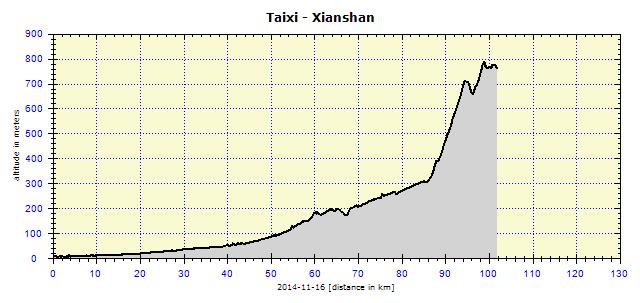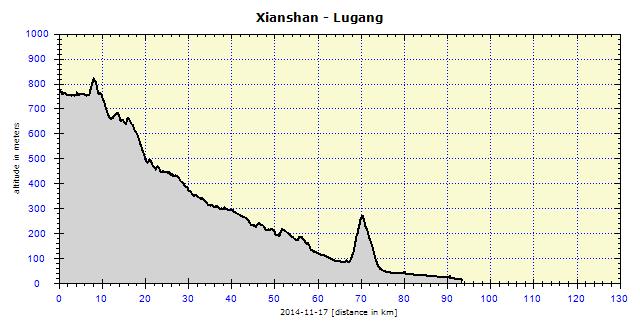
Nothing compares to the simple pleasure of a bike ride. J.F.Kennedy
Search this website
Taiwan, West Coast
Donghai, Wufang, Kaohsiung, Fo Guang, Qishan, Tainan, Budai, Douliu, Jiji, Shuili, Shuise, Yuchi, Guoxing, Lugang, Ershui, Kengkou, Taichung, Yanli, Toufen, Bali, Taipei
Kaohsiung
The destination of the day was not very far away — Kaohsiung, second largest Taiwanese city. I cycled to see the picturesque Dapeng Bay, but the morning light prevented any photography. The excellently equipped Visitors' Center was still closed, but I could wash and perform my basic hygiene. I made tea, had breakfast and slowly wandered towards the big city. Signposts directed me towards the bike path running along the road on suspension pylons. What a terrible choice! I had to push the bike up the steep steps which had a narrow ramp for bikes in the middle. Several kilometers later, there was an equally steep descent. I was afraid I would not be able to hold on to the bike. So I rather pulled it over the high curb on to the road against the traffic, reached a turnoff and took a minor road.
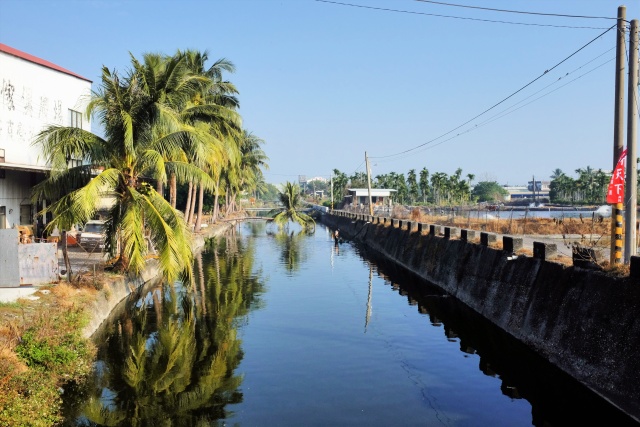
Wufang: Palms
The road led me through an industrial suburb smelling of chemicals on to Road 17, which had a lane reserved for scooters and bikes, so it was cool. I had found a hotel in the guidebook near the railway station and started to navigate according to the printed map as I approached the center. Somehow, the map did not match the location, until I realized that I was looking at the city of Tainan (it was an inset on a larger map and the plan of Kaohsiung was below). However, not even the correct map guarantees hassle-free travel. The street on the map was called Zhonghsan, while street signs called it Jhonghsan. And the GPS map was not aware of the existence of Kaoshiung at all, offering instead an entirely different transcription starting with a G.
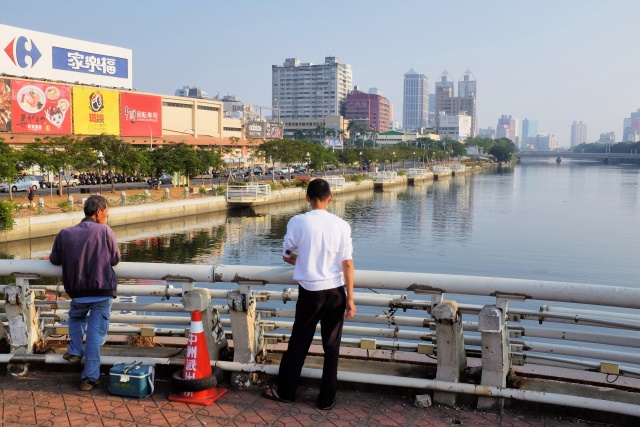
Kaohsiung: Love River
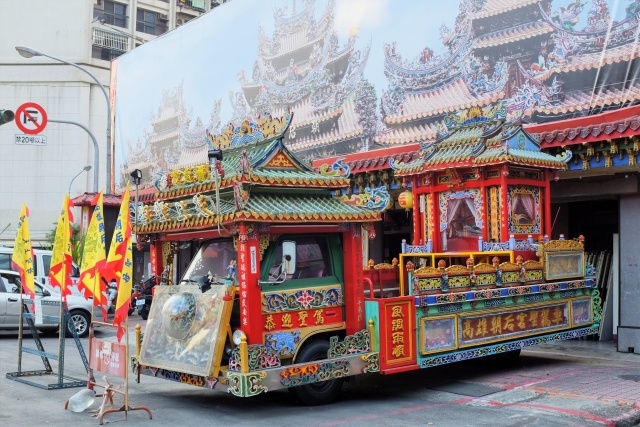
Kaohsiung: Buddhamobile (based on Popemobile)
I found the hotel easily, and they accommodated me before noon already, which was great. I had to recharge all the devices, update my online blog and handle a few work-related issues. In the afternoon and evening, I visited the city. There is not much to see, besides large shopping zones which hold little appeal for me. The local 347.5-meter skyscraper — 85 Sky Tower — was the highest building on the island until 2003, when a Taipei skyscraper surpassed it. Electric boat cruises on the Love River and the night markets are popular. One was near the hotel; I ventured there at dusk to taste some specialties.
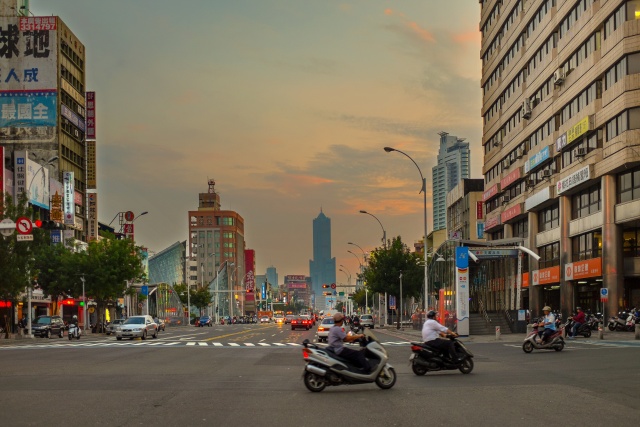
Kaohsiung: 85 Sky Tower – the second tallest building in Taiwan – in the background
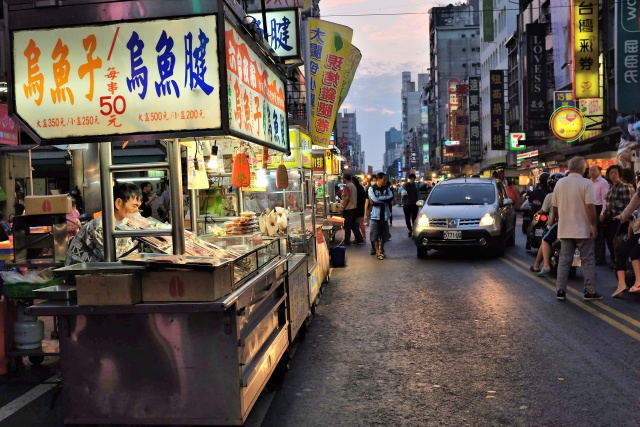
Kaohsiung: Luiho night market

Kaohsiung: Selection on the night market
There was a laundromat, where I washed a few items of dirty clothes. The service surprised me: coffee, tea, juices, ice-cream, popcorn and several light snacks were available to customers free of charge 24 hours a day. I also relished the hotel comforts the next morning. The breakfast was one of champions; I had to digest it before getting on the bike again.

Near Fo Guang: Shrine
Fo Guang Shan Buddha Memorial Center
I set off before 10:00 and headed inland. My destination was the Fo Guang Shan Buddha Memorial Center. This is a recently built Buddhist complex of buildings, nothing historical, except the interior decoration and art objects in the galleries. The spacious square is dominated by the main hall, above which is a 100-meter Buddha statue (height including pedestal). There are eight pagodas lining the square, dedicated to various fields of human activities and skills. Each pagoda contains exhibition premises on a theme (e.g. One-stroke Calligraphy). The main hall houses several museums, an exposition devoted to the Buddha’s life and several shrines (where it is forbidden to take photos). Nephrite Shrine is the holiest, containing relics of the Buddha’s teeth. At the time of my visit, a book fair and an exhibition on a healthy vegetarian diet were being held. The parking lot was crammed with buses, and visitors consisted mainly of retirees and schoolchildren on excursions.
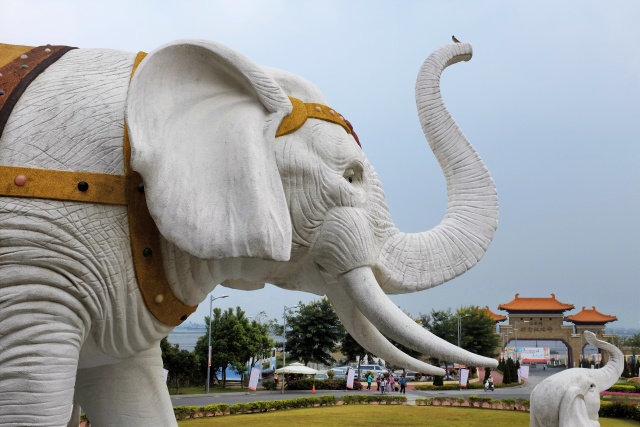
Fo Guang Shan Buddha Memorial: Kitschy elephant at entrance gate
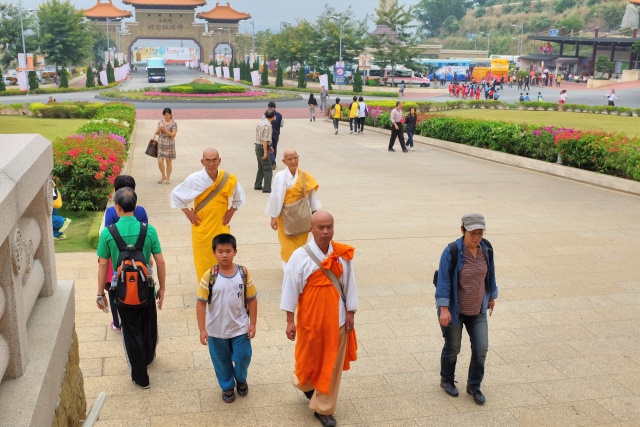
Fo Guang Shan Buddha Memorial: Monks arriving
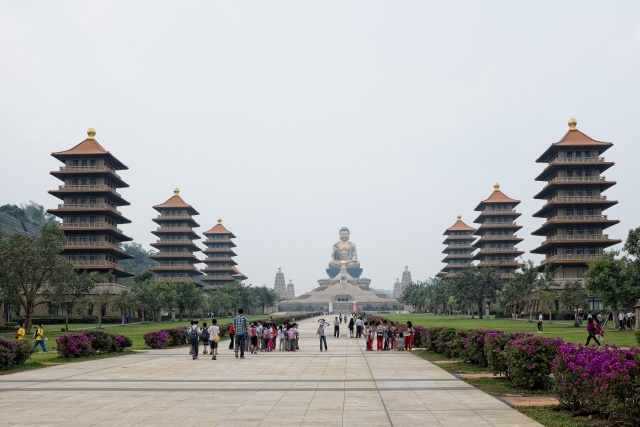
Fo Guang Shan Buddha Memorial: Pagodas line the way to the giant Buddha statue
It was interesting and I was very glad to have found it. The site was not on the map; there was only partial information in the guidebook. There were also no signs in the street with information about the Memorial. I had to ask for directions several times. My only complaint was the sultry weather; it was cloudy, the sky was steel gray. I bet that it would rain, but surprisingly, not a drop fell.
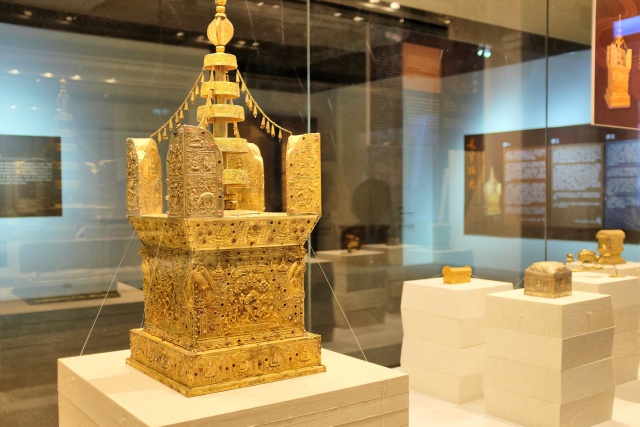
Fo Guang Shan Buddha Memorial: The most valuable item in exhibition of Chinese Buddhist artifacts
I stayed there for a while, leaving only after the second hour. It was obvious that I would not make it to Tainan and so would bivouac somewhere along the route. The minor roads that I took wound through agricultural landscape and small villages, where they can not afford to waste space on parks or facilities. Every inch of land that was flat was cultivated; the chances were minimal of finding a decent place to sleep. I prolonged the search almost until dark. By then, the requirements are already decreasing and one is grateful even for any slightly flat surface. What I found was a loamy meadow. I cleaned myself with wet wipes instead of washing and had a ten-hour sleep.
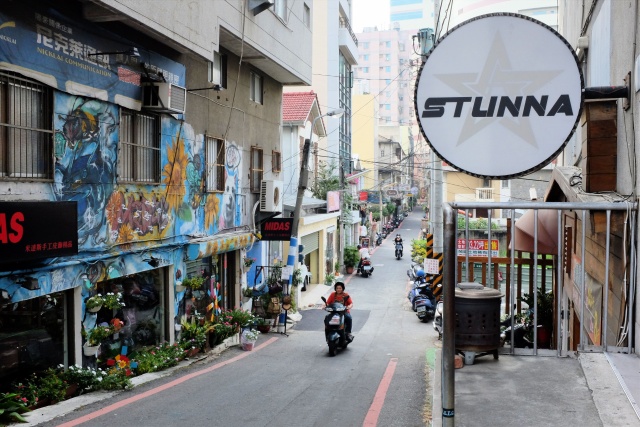
Tainan: Street in the center

Tainan: Lottery ticket salesman
Historical Tainan
I'd had a good night’s rest. After 06:00 I departed, reaching Tainan just after 09:00, where I went on a sightseeing tour. There are many important sights in this former capital of Taiwan. The oldest Confucian Church with minimalist decoration is remarkable. I also liked the tiny Temple of the Five Concubines outside their tomb. And many more; the city is packed with monuments and they kind of began to merge into one for me. Besides, the churches sometimes adjoin each other so tightly that it is hard to tell where one ends and the other begins. It pleased me that access is not restricted in any way and one can see everything properly up close. There are plenty of small statues lying about freely in the temples. I wondered that nobody stole any. Perhaps the morals of the visitors are enhanced by the grim-faced figures of guardians and demons, as well as the pervasive aroma of sweet-smelling burning incense.
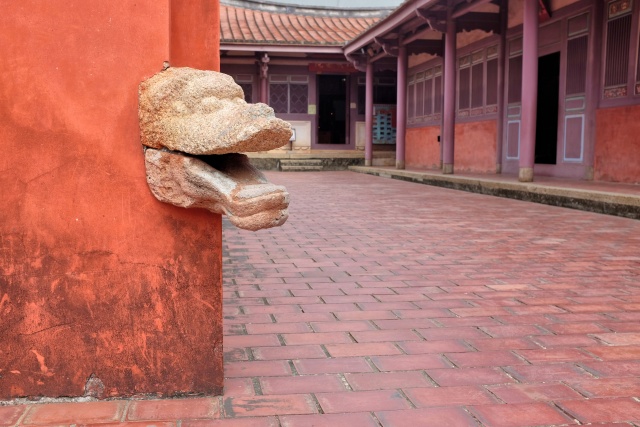
Tainan: Confucius Temple – dragon, or crocodile
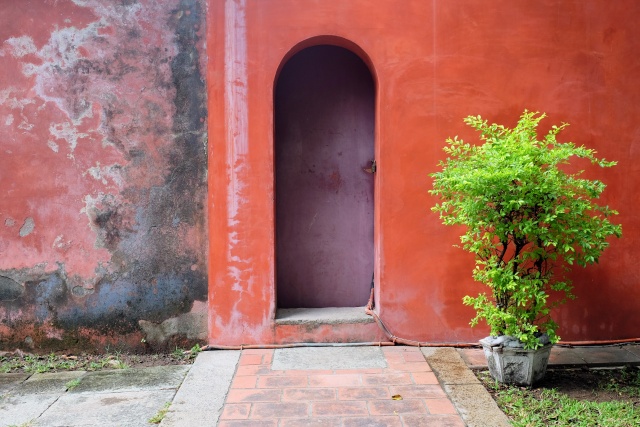
Tainan: Confucius Temple – essential mildew
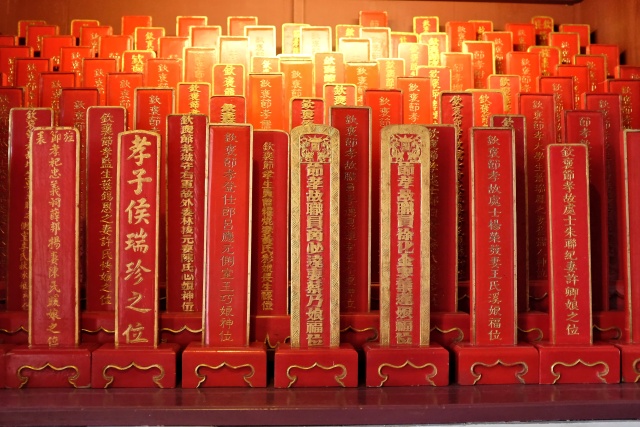
Tainan: Confucius Temple – rationally conceived decorations
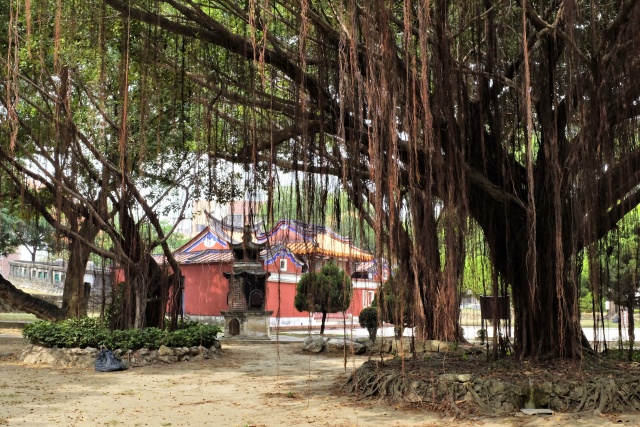
Tainan: Temple of Five Concubines

Tainan: Temple of Five Concubines – entrance portal

Tainan: Temple of Five Concubines – decoration detail
After noon, I tried one small, cheap, obscure hotel at the railway station where I found instant accommodation. Then I made a mistake – instead of taking the bike, I walked to Anping more than 6 km away to see the remnants of the original Dutch port. Another fortress was right in the center, but only its foundations remained and two pavilions were later built on the site – Chihkan Tower. Only a half-broken wall survived of the Anping fort, and all one could see were the later structures, not worth the visit. On my return, I made another mistake. Wanting to avoid an hour-long walk, I waited for the bus. The bus came 45 minutes later and the journey to the city center took an incredibly long time – almost exactly one hour. The bus drives around all the city sights, which could have been interesting in the daylight.

Tainan: Chihkan Tower – pavilions on the site of former Dutch fort

Tainan: Chihkan Tower – waterfall with fish
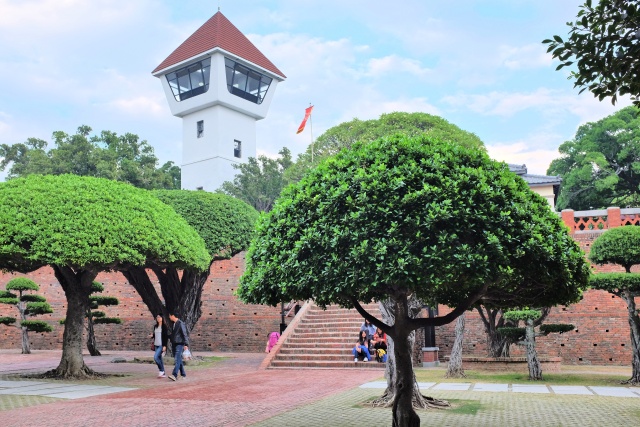
Tainan: Anping – former Dutch fort
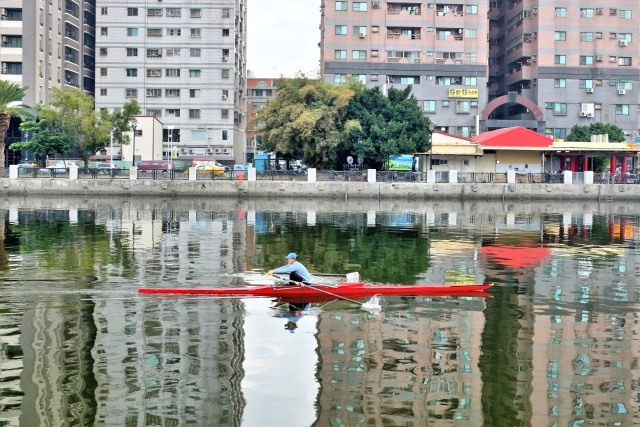
Tainan: Anping – rower in the canal
Next morning, I did not stay in the city, but headed north along the coast. Which was pretty boring: a plain with marshes, many ponds along the road where fish are bred. I saw many birds, even fish flopping about. However, it could not be helped, it was not much fun.

Near Aping: Herons
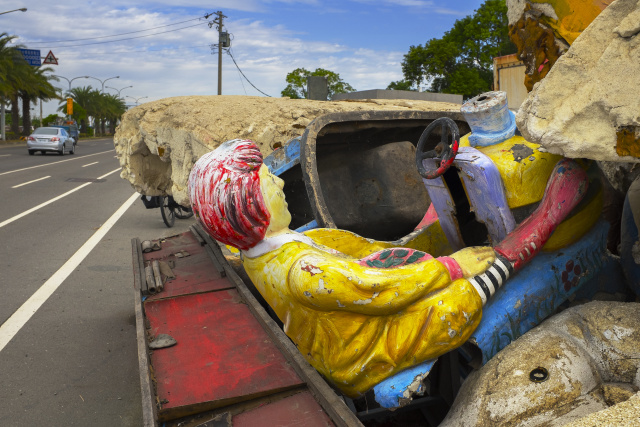
Near Qigu: Dump

Qigu: Pond

Jiangjun: Church
The boredom only ended in Budai, where the famous Nankushen Temple is situated. It is new, very decorative, vast and well constructed. The weekly festivities, which were to start several days later, were being prepared at the time, yet it was full of people. Most visitors had brought their domestic mazuch for blessing. People with the little gods had to register, obtain a number and then patiently wait for admission. A real buzz, lots to see. I stayed there for almost three hours. Which is a long time in the local short days when it got dark soon after 17:00.
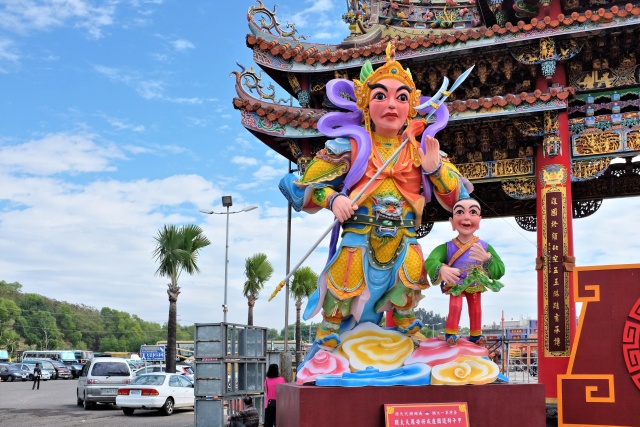
Budai: Nankushen Temple – paper statue in front of entrance gate
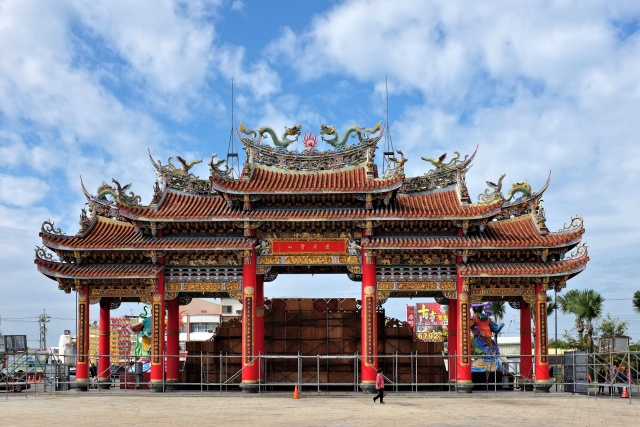
Budai: Nankushen Temple – main gate
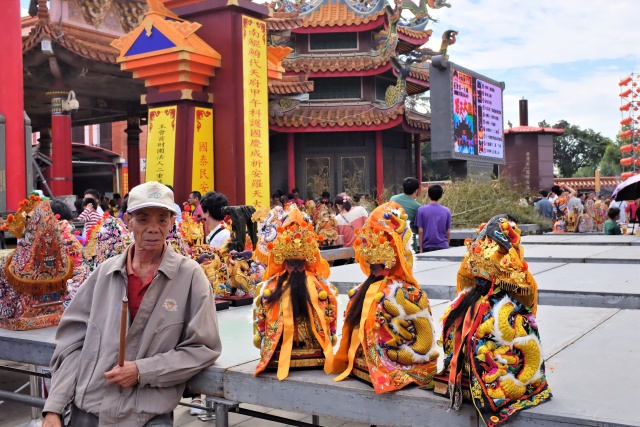
Budai: Nankushen Temple – exhibition of household gods
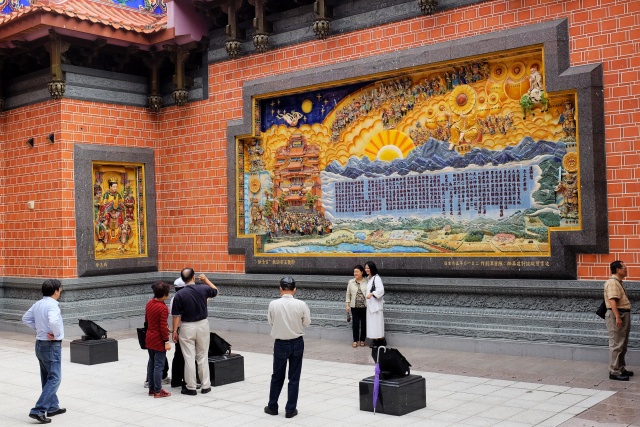
Budai: Nankushen Temple – inner courtyard
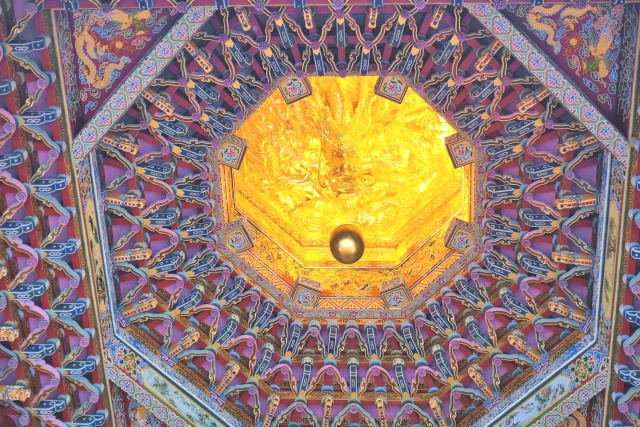
Budai: Nankushen Temple – ceiling detail
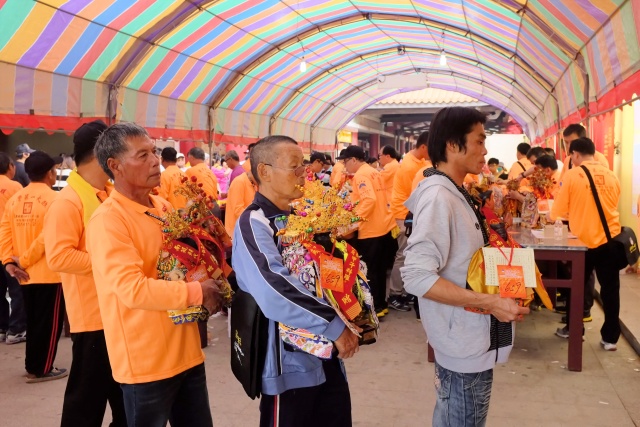
Budai: Nankushen Temple – line for blessing of household gods
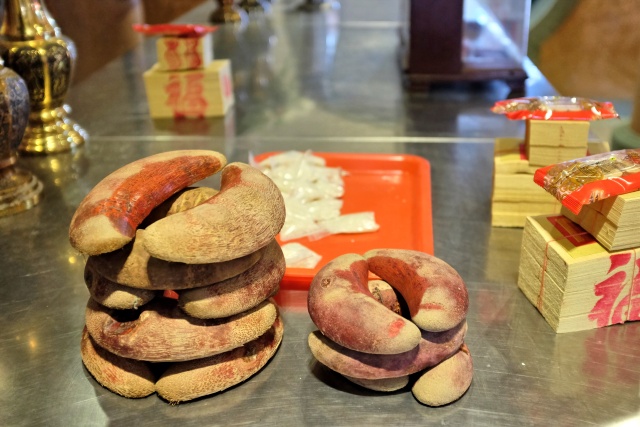
Budai: Nankushen Temple – stones are cast on to the floor after prayer, their mutual position revealing the success of the plea
Sun Moon Lake
It was time for the daily routine of searching for a place to sleep. I have to confess I enjoy this part of travel tremendously, as it is a diversion. Although I can understand why some people get nervous already at noon if they do not know where they are to lay their heads that night. There were toilets and faucets at a modest temple, actually just an assembly hall. There was a small lawn next to it, just big enough for me. I asked an old man who was passing by if I was allowed to pitch a tent there. He spoke English, understood what I meant and left to inquire inside. Not only did they allow it, but they let me into the showers, wanted to feed me (but I was already satiated). Moreover, they tried to persuade me to sleep inside, as it was cold outside. Which seemed really funny to me as I only covered the small part of my back with the sleeping bag to fall asleep in the heat. And one more thing, the old man revealed to me that he was already 61 years old.
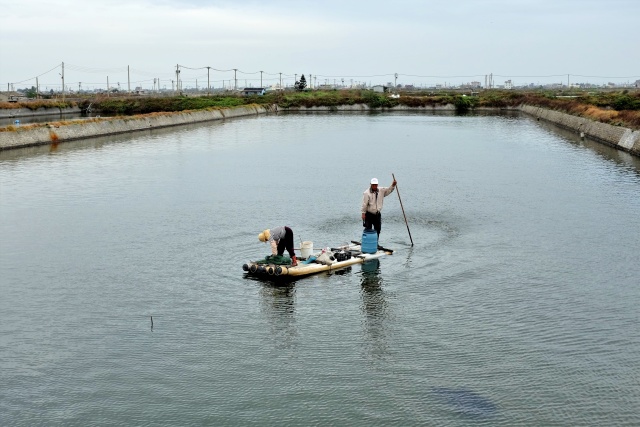
Kouhu: Raft on the breeding pond
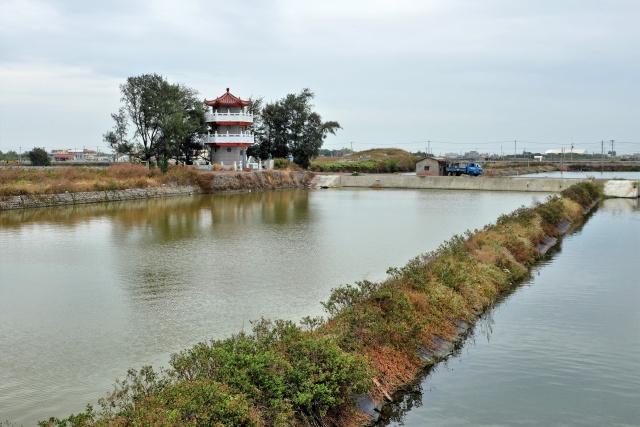
Kouhu: Small pagoda
The wind that blew that night had the strength of a hurricane and I was glad that I had not been lazy and had anchored the tent to the ground with pegs. The next day, I worried how I was going to continue in the wind. As I was bored by all the flat plains, I headed towards the mountains to see the Sun Moon Lake in the central part of the island. And indeed, it was a toil, especially in the morning with the wind directly in my face. Then I turned due North-East, with the wind blowing from 10 o'clock, which was significantly better. After 90 km of cycling, the road began to ascend sharply, which was quite a bother. Fortunately, I had eaten well enough for that. But of course, the sight of the lake rewarded me, I arrived at the Xiangshan Visitor Centre, crowded with Sunday visitors. After dark, I pitched the tent on the lawn beside the bike path.
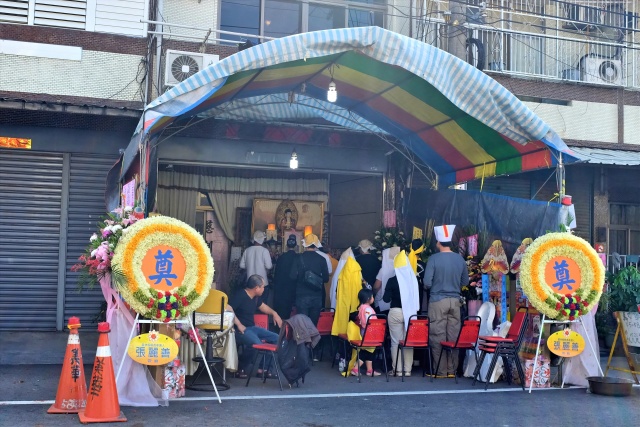
Douliu: Household celebration
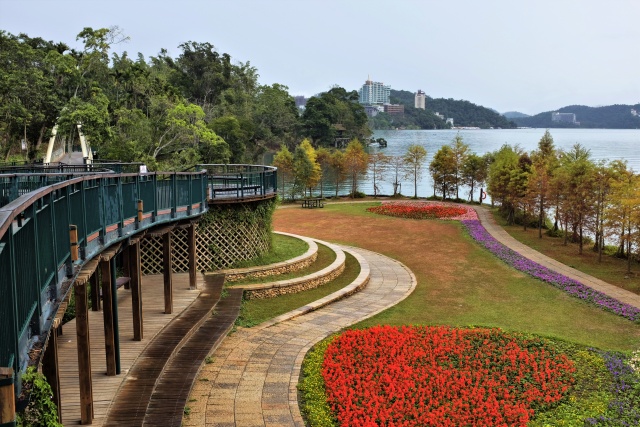
Sun Moon Lake: Bike path, I pitched my tent in the middle below it
My eating habits had changed. In the morning, I made an instant porridge and this was my fuel until noon. I was tired of the instant 7-Eleven meals, so avoided this combini. At most, I had light "dog food" (my private name for it) – rice or rice-meal sticks and balls served in weak hot soup. This is similar to Korean fishcakes, which I actually fancied. Indeed, the soup is important, as it provided me with fluids. I ate proper meals exclusively at small "garage" pubs that are found in almost every village. That is why, when passing inhabited areas, I monitored the catering facilities with lots of people, then looked at the menu and either decided to stay or to move on to several buildings further on. Cookshops offering up to 20 different meals – roast meat, fillets, fish, vegetable, salads – are the best. I put what I liked on my plate, the female cook added it all up and announced the total (usually 70 to 100 Taiwanese dollars – $2 to $3). There was always a bowl of rice with the meal and where there is rice, there is no room for hunger (as a classic author – i.e. I – state). Afterwards, I scooped misa soup with herbs from the kettle. Its purpose is to soothe the stomach and at the same time help to dissolve the fats just consumed. If it tasted good, I took a portion away for dinner. By the way, it never happened that it did not taste good.
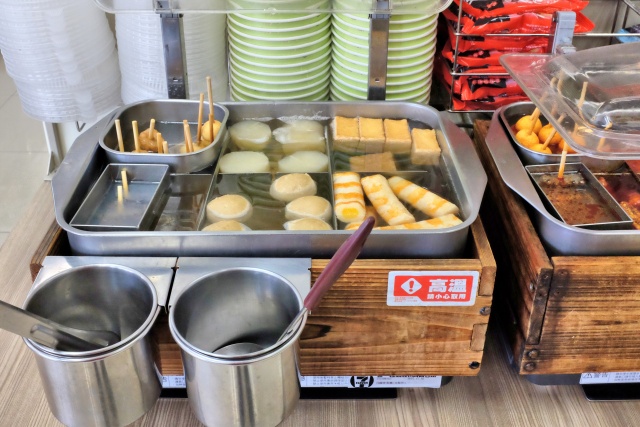
Wufeng: Dog food in 7-Eleven
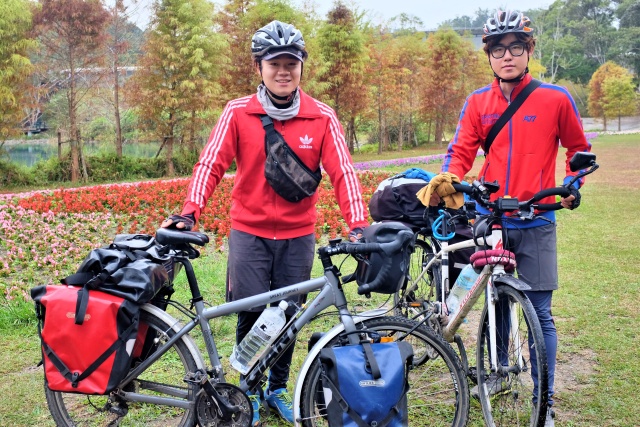
Sun Moon Lake: Korean cyclists
It rained that night, the tent held up well and my opinion of it improved. I waited for a short break around 07:00, jumped out of the tent, packed up my belongings – and it began to pour again. Close to me, two Korean students emerged from a tent. They had been on the road almost exactly as many days as I, cycling from Korea to Hong Kong. I asked them about China – they liked the beautiful monuments but not so the people, whose only interest was money.
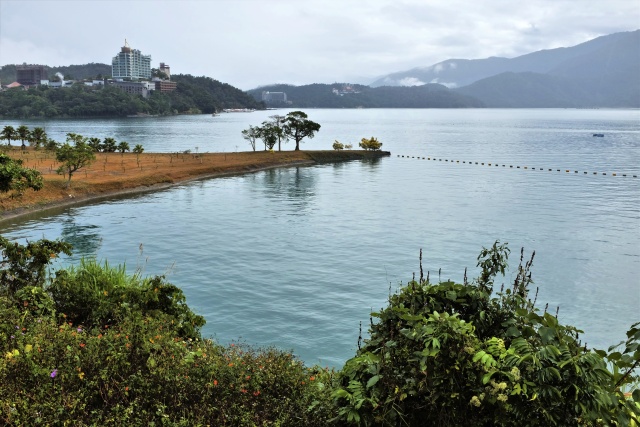
Sun Moon Lake: View of Shuise
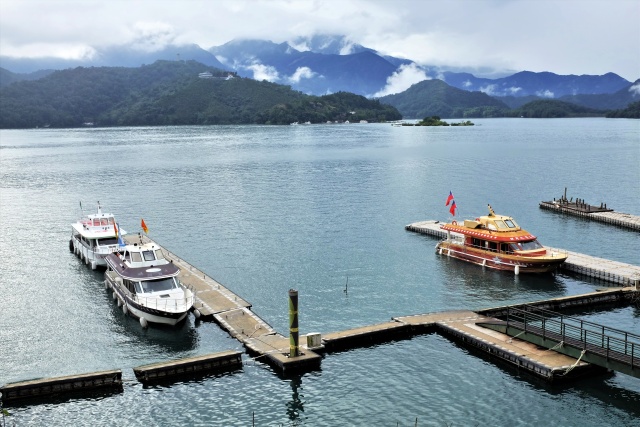
Shuise: Ferry harbor
Sun Moon Lake was fancied by Chiang Kai-shek. In my youth spent in socialist Czechoslovakia, he (like Tito) was considered the worst criminal under the sun. In Taiwan, he is a very respected politician. He had a house on the hill above the lake and below that built a small Christian house of prayer, the Church of Christ, which he and his wife attended regularly. It is not possible to photograph the Church, as it is on a steep slope surrounded by tall trees, so I only shot a part of the portal.
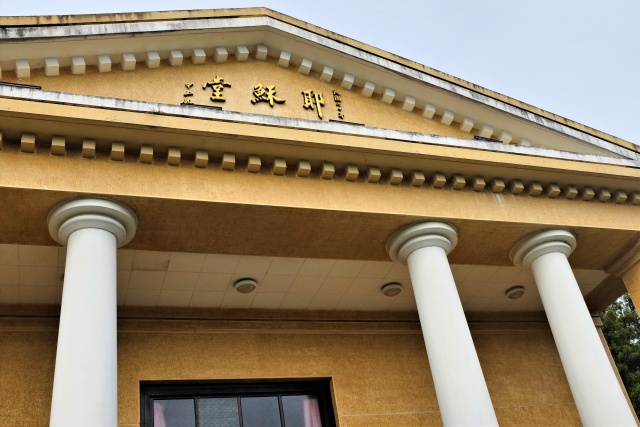
Shuise: Portal of Church of Christ, built on order of Chiang Kai-shek
I cycled around part of the lake, the whole path is 35 km long. I feasted my eyes on the vast Wenwu Temple, then visited the small Kongmin Temple with the biggest Taiwanese statue of a "marriage broker". The church is popular with couples about to make the decision to marry.

Wenwu Temple: Prayers and wishes posted on the church fence
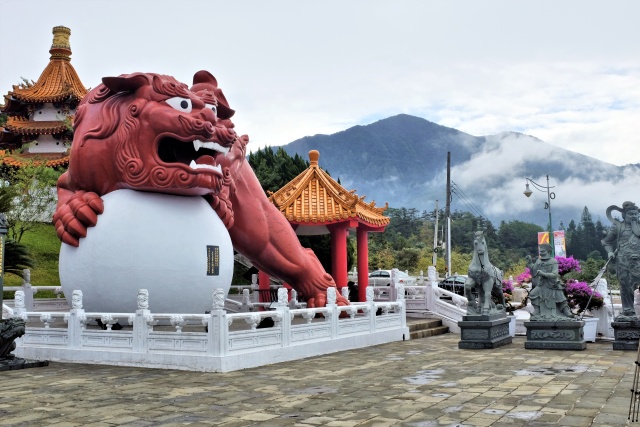
Wenwu Temple: The entrance is guarded by really angry lions
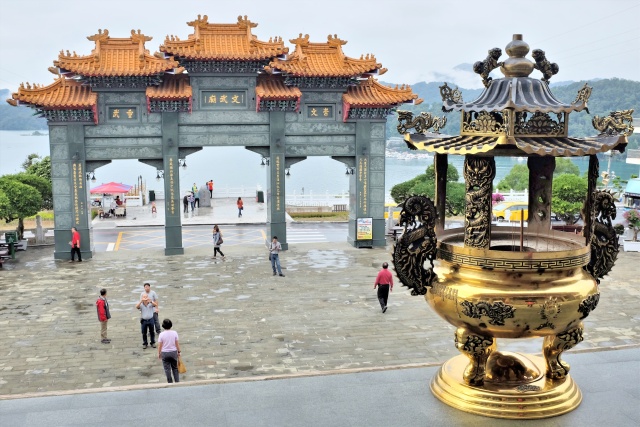
Wenwu Temple: Entrance gate
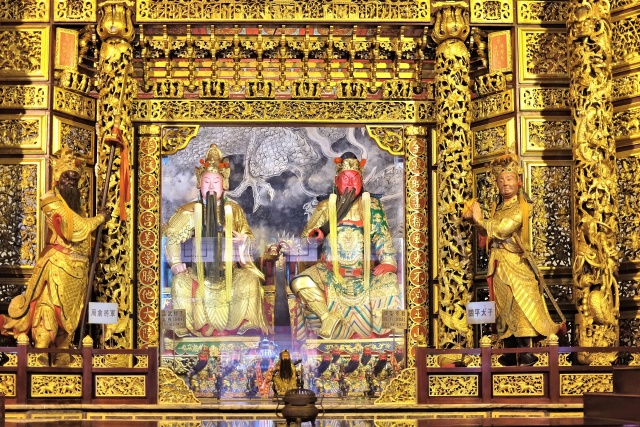
Wenwu Temple: Altar in the main hall
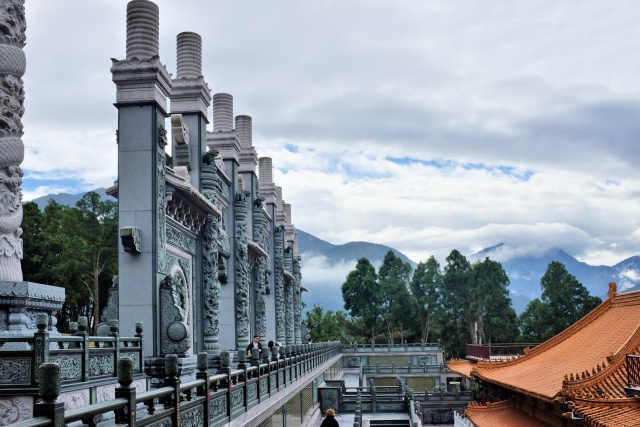
Wenwu Temple: Gateway to gardens above the church

Wenwu Temple: View of Sun Moon Lake
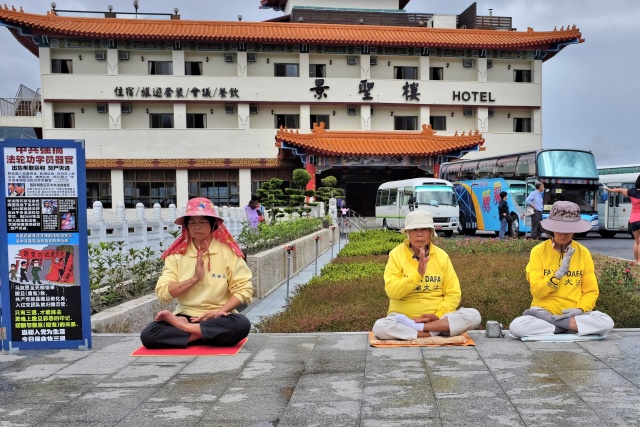
Wenwu Temple: Women protesting against discrimination of Falung Kung in central China; they have no problems in Taiwan
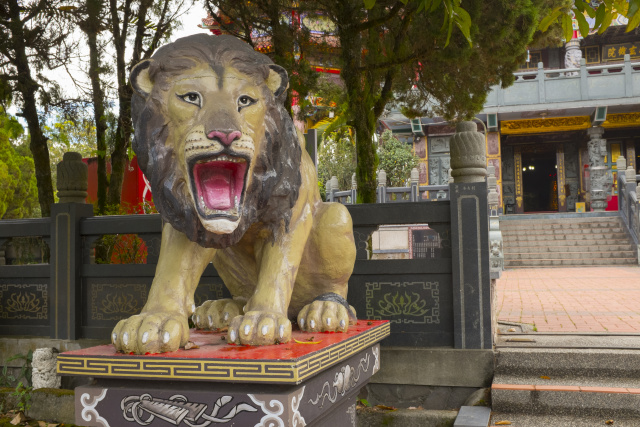
Kongmin Temple: Lion at the entrance

Kongmin Temple: They look like 3 kings

Kongmin Temple: Popular statue of marriage broker
I left in a westerly direction; my destination was Lugang, a small town, but packed with authentic monuments. My GPS did not know it, eventually I found that it was inscribed as Lukang. Anyway, I found an approximate point based on the shape of the coast, and let the GPS direct me. First I grumbled when the navigation directed me away from an easy road about 20 km before the destination and dragged me along a steeply ascending forest path. But after pedaling hard, I enjoyed cycling on quiet roads where there were not even any cars with election promises. The campaign was truly massive there, there were billboards, flags and banners along the roads; cars, motorbikes and even bikes had posters pasted all over them. There were also blaring loudspeakers propagating individual parties.
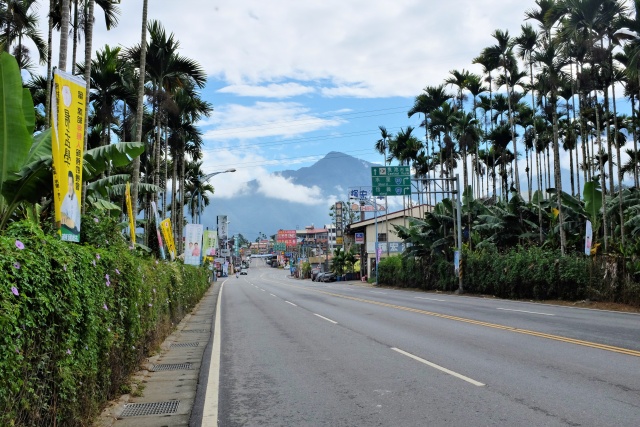
Yuchi: Road to town
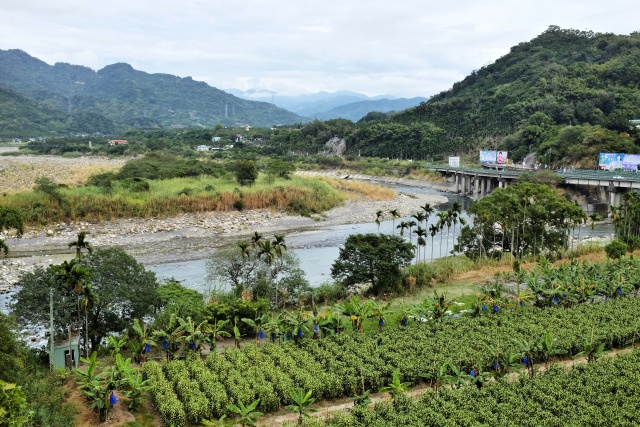
Guoxing: Mountainous landscape
Combining the Kindle and GPS maps, I found a hotel in Lugang recommended by the guidebook, as I needed the Internet and laundry. I received neither. Moreover, they had innovative, multiple-use paper towels and cloths, instead of ordinary towels. These had only one disadvantage: one could not dry oneself with them. It was dark, I could not go anywhere else, so I stayed there much to my displeasure.

Lugang: Tianhou Temple – donation box
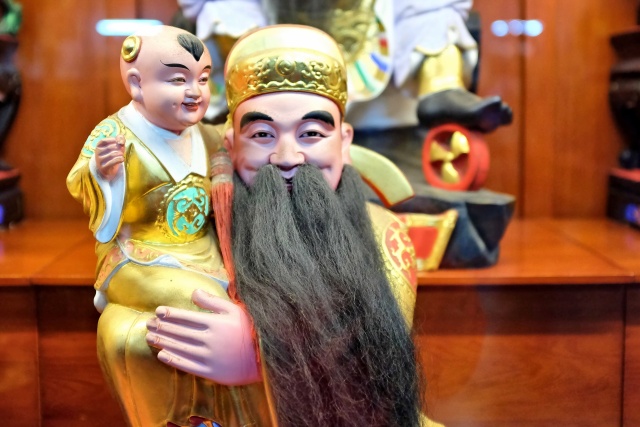
Lugang: Tianhou Temple – a beardie instead of the Virgin Mary
But the monuments were great. Some churches are really tiny, squeezed between newer developments, but they have an authentic atmosphere and it impressed me. I ate at the night market, roamed the city and was happy.
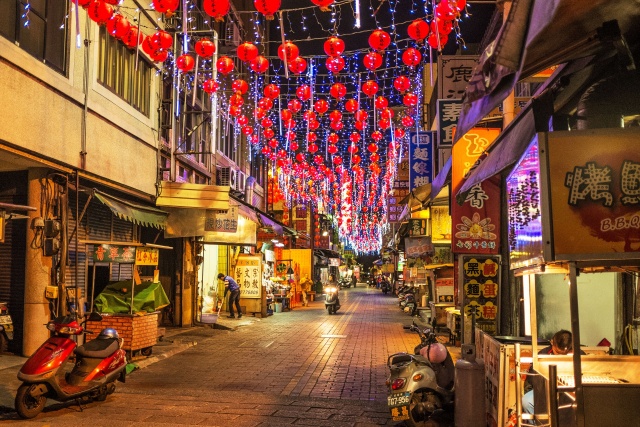
Lugang: Night market in Wenkai Road
The next day, I woke up early, saw the main sights and walked through the narrow twisting streets of the town.

Lugang: Chenghuang Temple – wooden statue
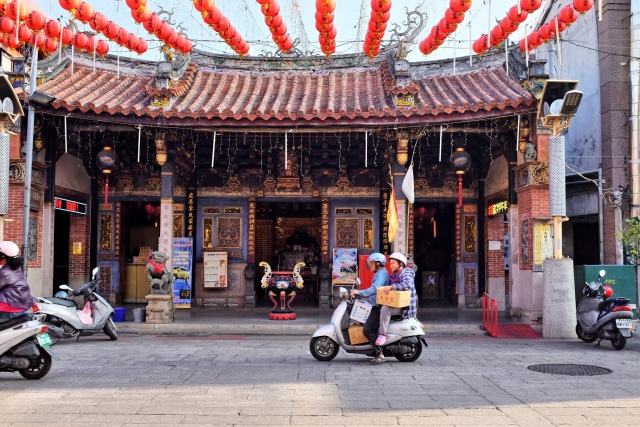
Lugang: Chenghuang Temple
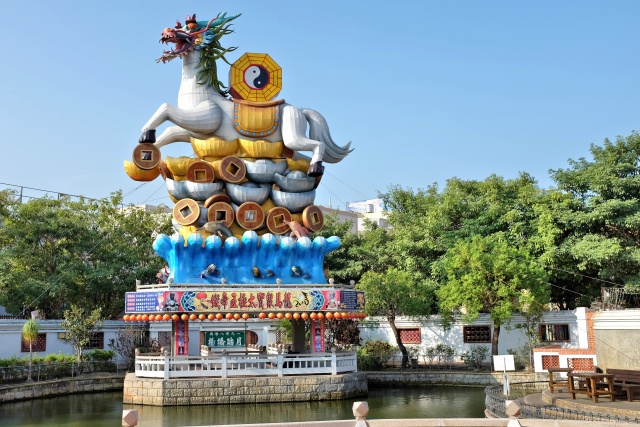
Lugang: Tien-Hou Temple – horse with dragon's head
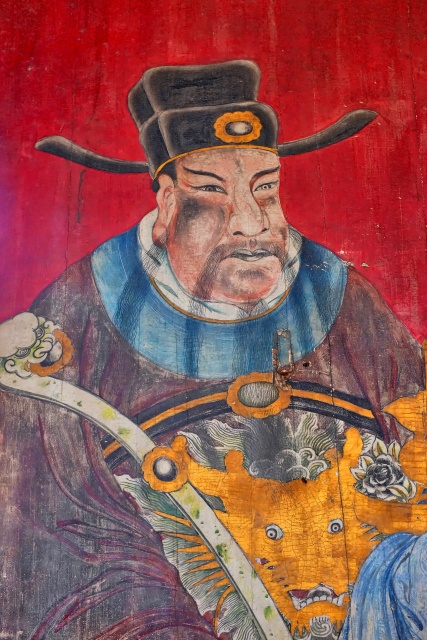
Lugang: Longshan Temple – painting on wooden entrance door
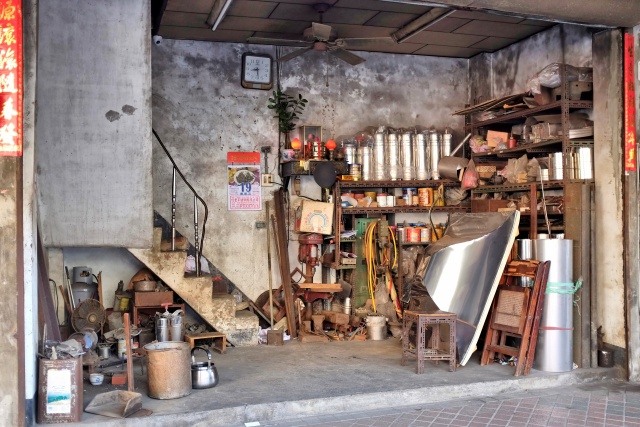
Lugang: Workshop
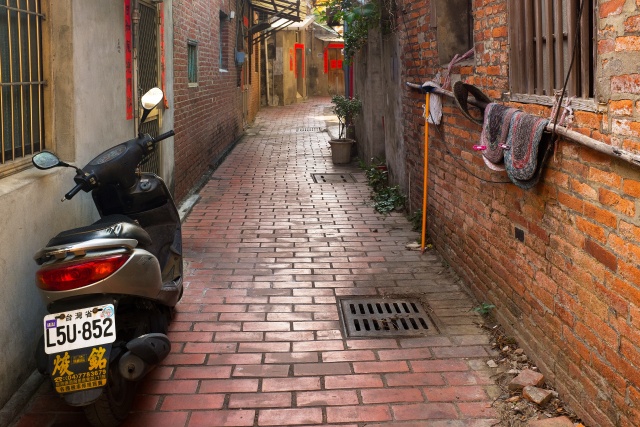
Lugang: Narrow streets in historical part of town
Exactly at the check-out limit of 11:00, I left the hotel for Ershui, in the vicinity of which wild macaques live. There are no rules for seeing them, but the best time is in the morning around 10:00, or in the afternoon between 14:00 and 15:00. Thanks to the wind from behind, I caught the afternoon time. The railway station in Ershui was near the Visitors' Center, where the girl equipped me with a manually drawn plan of how to reach the parking lot, which is the starting point to the reserve.
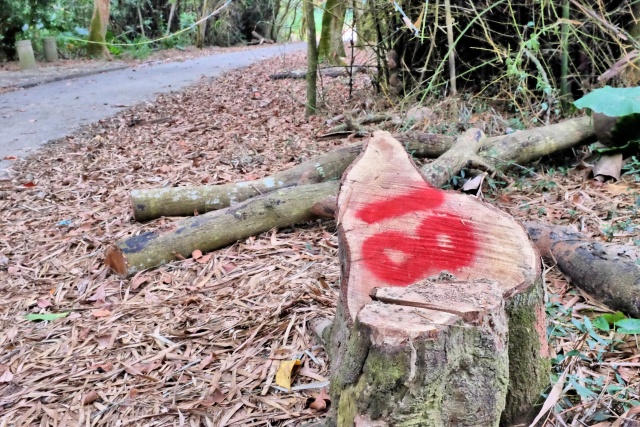
Ershui: Taiwan Macaque Protection Area – fallen tree
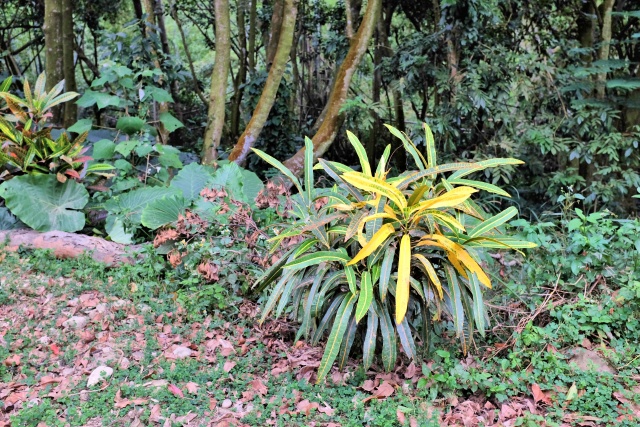
Ershui: Taiwan Macaque Protection Area - plants
I leaned my bike against a tree; I did not lock it any more, it was a waste of time. I was lucky, seeing a few monkeys. To do this I had a two-hour walk through a wild forest, amazing. My overnight resting place was obvious – I would sleep in the parking lot. Well, there was a 20-member pack of stray dogs, but after I bawled their leader out, they ceased to pester me. I cycled to Ershui to buy beer as accompaniment to my dinner in a box, which I had bought together with lunch. There was no one else in the parking lot; I pitched the tent under the roof of an outdoor amphitheater. The tent was wet from the rain two days before but, thanks to the fact that I had folded it properly, it was only sodden inside and dried in half an hour. I had no need to fear, because by the light of my forehead lamp, I saw the white of the eyes of the stray dogs who, from a safe distance, ensured my undisturbed sleep.
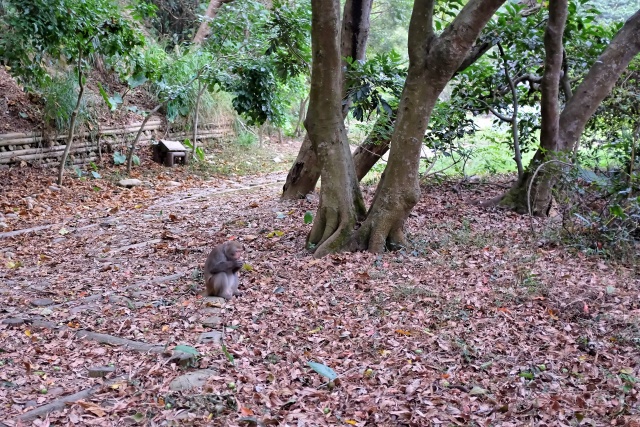
Ershui: Taiwan Macaque Protection Area - macaque

Ershui: Taiwan Macaque Protection Area – macaque showing off his teeth
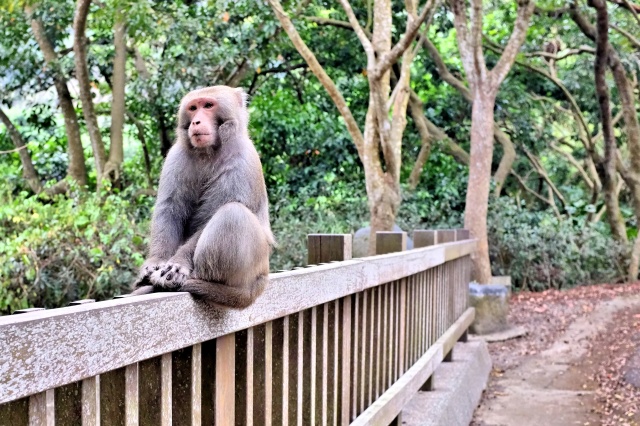
Ershui: Taiwan Macaque Protection Area – typical Taiwanese macaque

Ershui: Taiwan Macaque Protection Area – macaque or child?
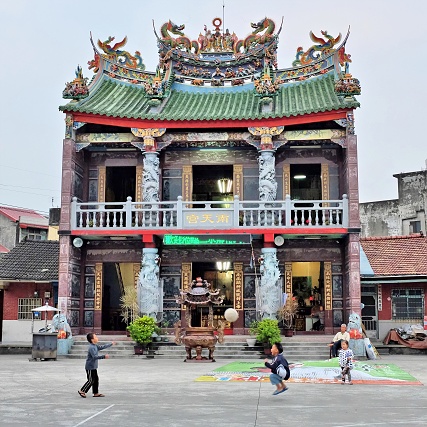
Ershui: Playing in front of the church
I extended my circular tour of the interior, evoked by my aversion to route planning, with a visit to the 921 Earthquake Museum of Taiwan. It was hard to find. My GPS map erroneously positioned the facility 50 km further on. I combined the information from the guidebook in Kindle ("The Rough Guide to Taiwan") with the tourist map of the island and finally had to ask some workers in a small village. When they eventually grasped what I wanted, they drew a rather accurate plan on a piece of paper. And they added mandarins from their orchard.
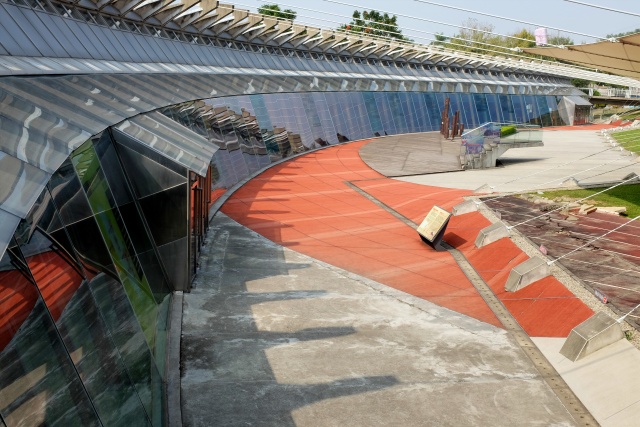
Kengkou: 921 Earthquake Museum – futuristic building with outdoor exposition
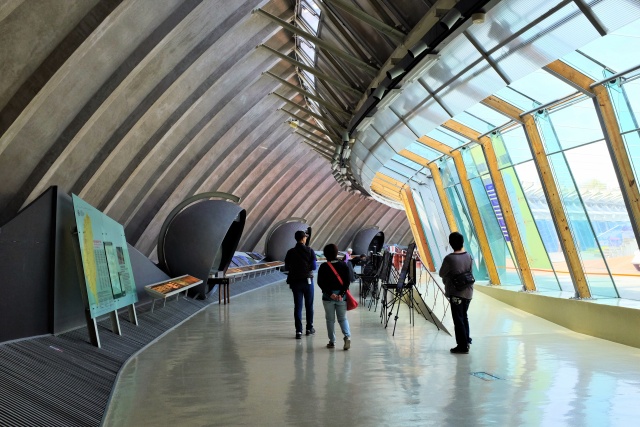
Kengkou: 921 Earthquake Museum – futuristic building with indoor exposition
I do not know why, but cycling was really smooth that day. I rushed easily up a hill with a 200-meter superelevation (it does not seem so, but the vertical distance is huge, just test it on yourselves one day). Three sportsmen on road bikes, wearing color-coded outfits, overtook me approximately 200 meters below the summit, gestured appreciative thumbs up and passed me. As I struggled towards the summit, I pedaled more vigorously and soon overtook the first of them. Finally, I beat all of them, and when they reached me at the crossroads where I was waiting at a red light, I theatrically thumped my chest with my right hand, showing them a raised index finger. They took it with humor. Only I was surprised at how seriously I meant it.
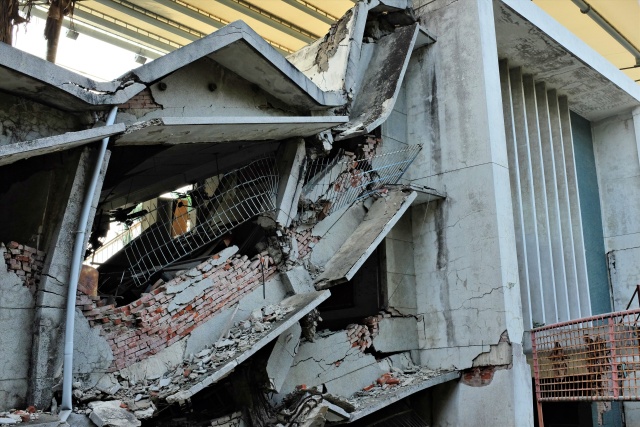
Kengkou: 921 Earthquake Museum – collapsed school building
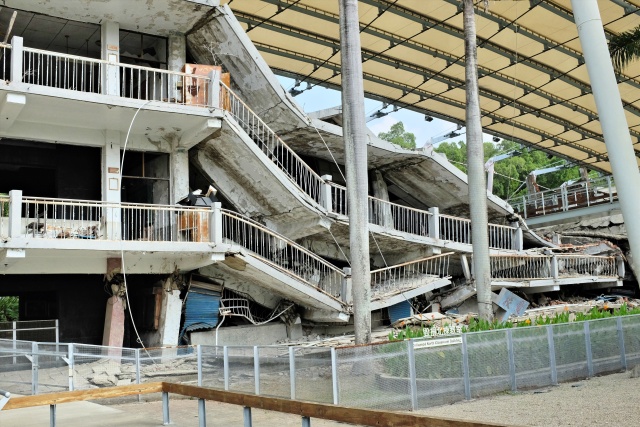
Kengkou: 921 Earthquake Museum – collapsed school building
The 921 Earthquake Museum of Taiwan
The Museum is devoted to the 7.3 magnitude earthquake which Taiwan suffered on September 21, 1999 at 01:47. Hence the name of the Museum: 921. 2415 people lost their lives, 29 disappeared, 11 305 were injured. The damage was immense and in some areas has not been repaired to this day. Taiwan has the misfortunate of being an island situated on a fault line of the earth. The epicenter was in the city of Jiji in the central part of the island, through which I had passed on my way to Sun Moon Lake.
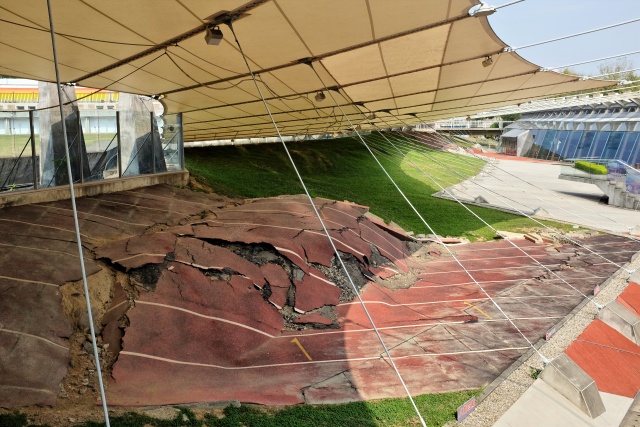
Kengkou: 921 Earthquake Museum – athletic track
The Museum is situated on the land of the Kuang-Fu Junior High School which was totally destroyed. Luckily, the children were at home at that time, otherwise not many of them would have survived. The ruins have been stabilized and covered with canopies. Several futuristic buildings with interesting expositions have been built around it. The most striking images of what was really a pogrom are shown in the photographs. The worst damage was caused by the second quake that was one-third weaker, but actually finished off the disrupted buildings from the first earthquake. I was particularly intrigued by the simulation of shakes: visitors sit on the ground in a chamber environment of a 30-m2 room, watch and hear an actual recording of the earthquake, while the floor beneath them vibrates, shakes and creaks. It is horrible, compellingly disturbing the trust in values considered as solid before that time ("keep your feet firmly on the ground," we were advised by our parents). What a relief we do not have earthquakes in the Czech Republic!
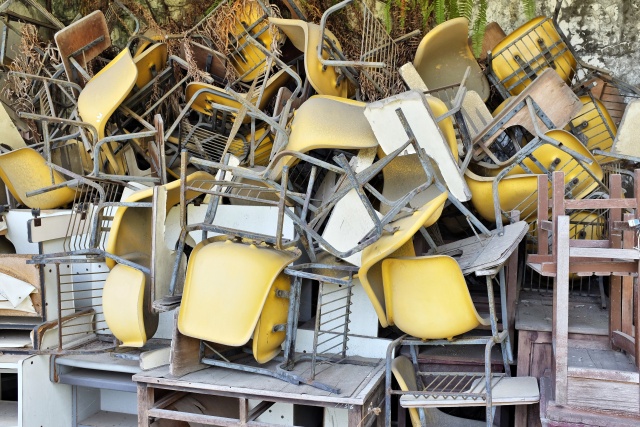
Kengkou: 921 Earthquake Museum – interior of one of the classrooms
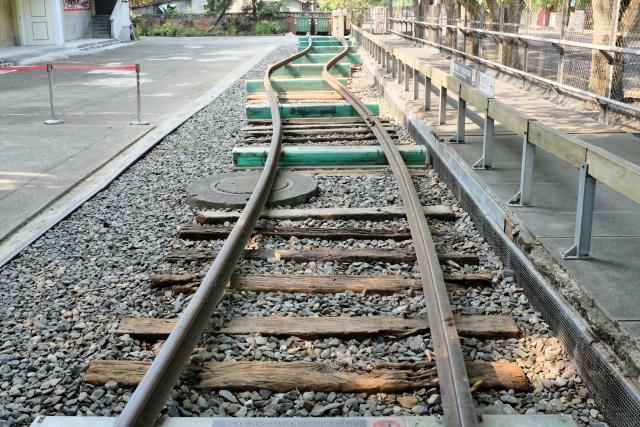
Kengkou: 921 Earthquake Museum – railway lines after earthquake
I spent quite some time in the Museum; it was interesting and I also wanted to enjoy the feeling that it was free of charge for dignified greybeards of my age. I reached Taichung via a conglomerate of cities. I guess this is the third most populous Taiwanese city. The city is remarkable in that there is nothing remarkable in it. I already had a backlog of blog writing. I had to pause, write and publish something. I do not want to complain in this connection but it is quite a labor – to cycle to a destination, find food and accommodation, process photos and put together a text, sometimes while intoxicated. Some readers complained that I should update my blog regularly, every second day, or at most at three-day intervals. But then I would have had to carry a press agent with me on the bike, and realize, even if he was skinny, an extra 60 kg would prove a considerable burden along the way.
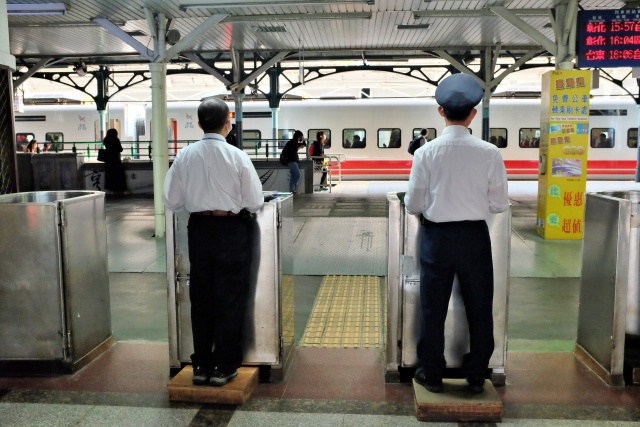
Taichung: Railway station
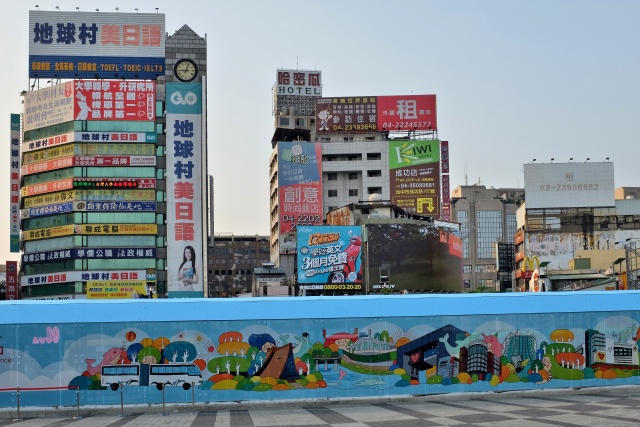
Taichung: Colorful buildings in front of the station
The following day could be described generally as great suffering. I do not know why, but everything went wrong from the morning. After leaving the city conglomeration, the wind beat into my face and it really stopped being amusing. I cycled lazily, resting at noon on a park bench. Locals even brought me a box of food in an attempt to resuscitate me. A distaste for a headwind is rational – it is a waste of energy. When I go uphill, I subconsciously feel that I am gaining potential energy which will be converted into kinetic energy at the summit. But energy spent in a headwind is lost without any effect. By the way – if you read cycling reports, have you noticed that a headwind is always strong, even brutal, while a wind from behind is mild? Cyclists feel it is like that.
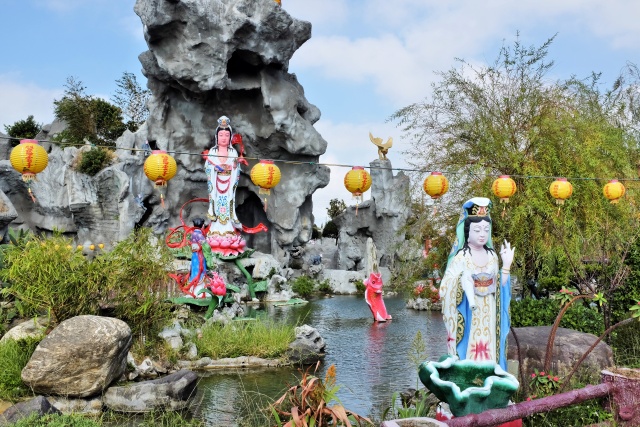
Yuanli: Cihyun Temple – artificial rock, lake and obligatory statues
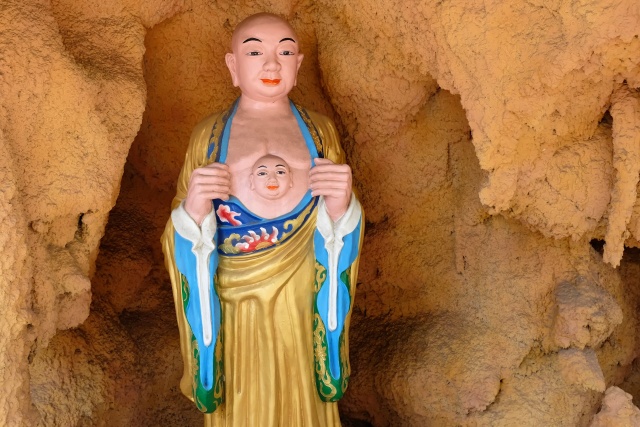
Yuanli: Cihyun Temple – alien making its way into daylight

Yuanli: Cihyun Temple – thousands of small Buddhas are present in every church, always properly numbered
My performance is usually the best in the evenings, which was also proven that day. The landscape began to change, shielding me slightly from the wind and I finally got going. I began with the routine evaluation of possible places to sleep. There was no chance of a decent campsite in the countryside, all the land was cultivated, as farmers are not in the mood for parks. So I headed for the city. I found several options in Toufen; the best was in a playground, the restrooms there had dry toilets but the faucets had running water. I saved the GPS coordinates and went to eat. There was a large supermarket in the center; I did not lock bike in front of it (which I do only in exceptional cases) and only took with me the handlebar bag with the camera. They had an excellent box with sashimi, to which I added 0.6 liter of local cooled frumentaceous beer, sat down on the curb outside the store and fed myself neatly with chopsticks. In addition, I had several pleasant debates with locals who mostly commented on how skillful I was with chopsticks. I consider them an ingenious type of cutlery, cheap and hygienic. Of course, the food must be prepared properly, rice gluey, meat cut up in advance. But it is really a pleasure for me to eat a whole fish and easily remove the bones from my mouth.
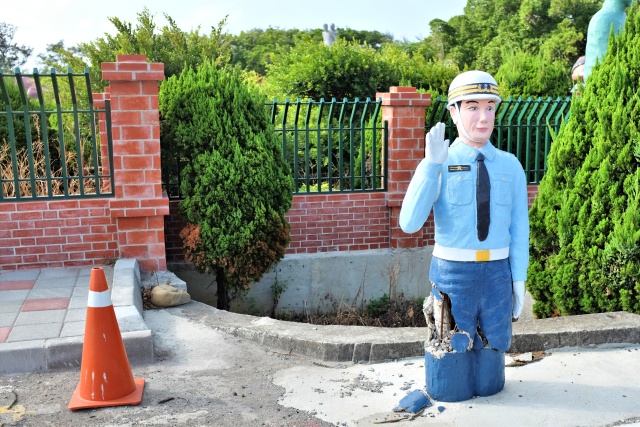
Yuanli: The Policeman was hit in his leg
I must correct the previous information about my tent. The humidity was high again and the flysheet was wet both from the exterior and interior. But when it rains, it is wet only from the outside. The problem is not in the flysheet fabric, as I had mistakenly assumed, but in the fact that the tent is conceived as one unit and separating the flysheet from the inside means undoing 16 joints. Whereas, with my previous tent, I put the interior tent on the pole structure and threw the flysheet over it. Then I could pack the wet flysheet separately and did not have to deal with the damp interior tent. This time, I coped with it at a stop in front of a small shrine. I pitched the tent in a sunny spot and meanwhile read in the shade. Half an hour later, the tent was dry and I could continue on my way.
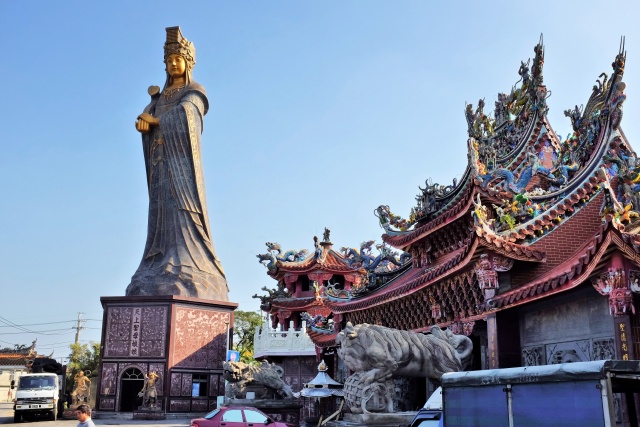
Yongsan: Statue, approximately 10 meters high
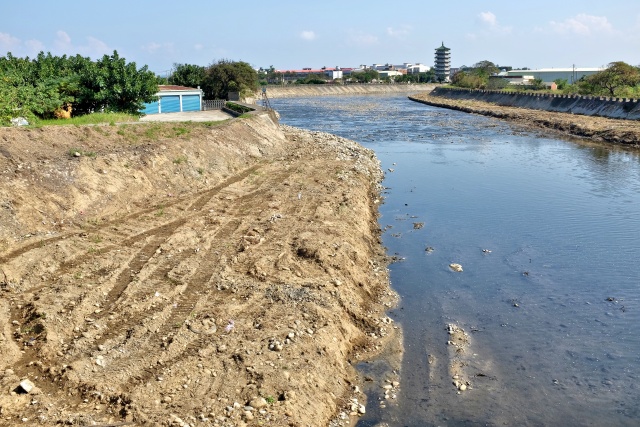
Dayuan: River near estuary
That day was the opposite of the previous one. I sparked with vigor, forging ahead like a carthorse, pedaling as if on a racetrack. Almost no wind, the hills disappeared, it was hot but I did not mind. 70 km later, I entered the road I had been on 17 days before, after arriving in Taiwan. The smell, which had surprised me then, was gone. Perhaps I had got used to it meanwhile.
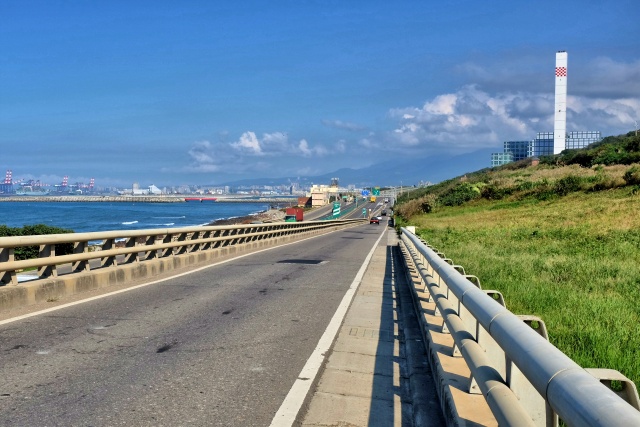
Bali: Arrival in the city: in the background the usual Taiwanese arrangement is seen – expressway in the middle with normal streets alongside it
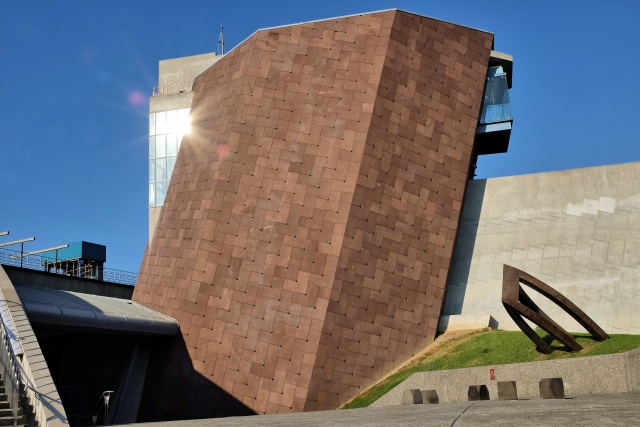
Bali: Shihsanhang Museum of Archaeology – the Museum building has won several awards
In Bali I visited the Museum of Archeology. This building has deservedly won many awards. Only the elevator was out of service and it was necessary to walk up four floors for a vista of the city. First, there was a full-scale model of the archaeological work. It reminded me of the stage of my life when, after graduating from university summa cum laude, the Bolsheviks did not allow me to work in the field and so I worked as an archeologist with a pen. On the foundations on which the Kotva shopping mall arose, I redrew the excavated skeletons on a 1:10 scale. The only difference was that my grid was squared 100 x 100 cm, while here they used the rectangle, which was more appropriate (the skeleton is seldom squared, perhaps only Marta Gottwaldová looked like that).
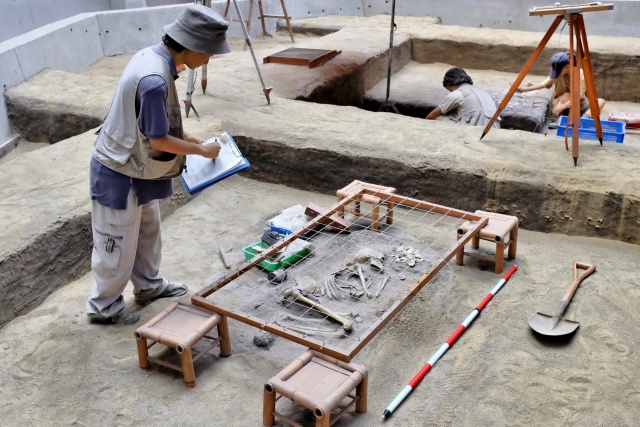
Bali: Shihsanhang Museum of Archaeology – I recalled my career beginnings after university graduation
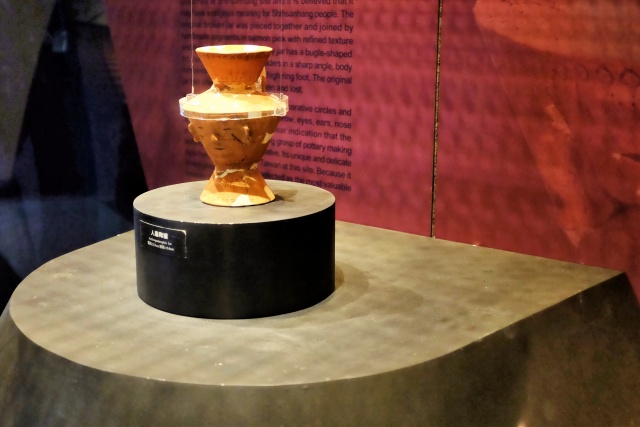
Bali: Shihsanhang Museum of Archaeology – vessel in the shape of a human hair – the most valuable exhibit
Honestly speaking, it is wasteful to use such a beautiful building for so few historical objects. The most valuable exhibit is a vessel with a human face, complemented by several pieces of evidence that prehistoric inhabitants were able to smelt iron, and a few Chinese coins to prove the early business relations with continental China. Visiting children pass by indifferently, as they are more interested in the puzzles, brain teasers and various games and tasks awaiting them in the Museum. Indeed, brain teasers dominate in the facility. The last fact of interest – there is no admission fee.
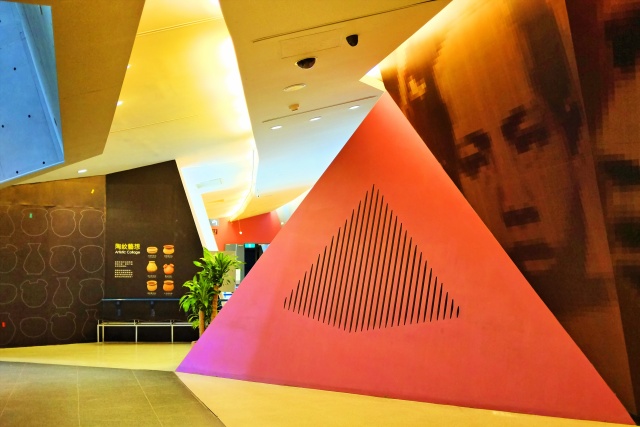
Bali: Shihsanhang Museum of Archaeology – interestingly segmented interior
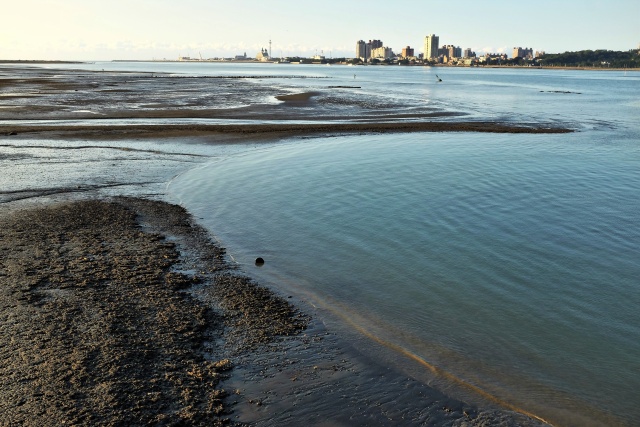
Bali: Coast – Tamsui River
Originally I intended to go to Frog Café, have a chat with the owners and sleep on their terrace. From the Museum roof, I saw a park on the shore, an ideal place to sleep, only the showers and water in the cooking shelter were closed as it was out of season. Wooden platforms provided a perfect foundation for pitching the tent.

Bali: Photographically convenient subject
I wanted to go to greet my acquaintances in the café, but I did not make it. On the bike path, a girl asked me to adjust her saddle. There was no fastening screw, I had to take out my spanner and Allen key. When adjusting the seat, I explained how extended her legs should be. Other cyclists became involved in the discussion and presented different opinions. The debate became intense; we released the girl out into the world and refined the strength of our arguments in a nearby pub. It was good that I had saved the GPS coordinates of the park for camping, otherwise it would have been difficult to find my way in the dark after the debate with the arguments properly washed in alcohol.
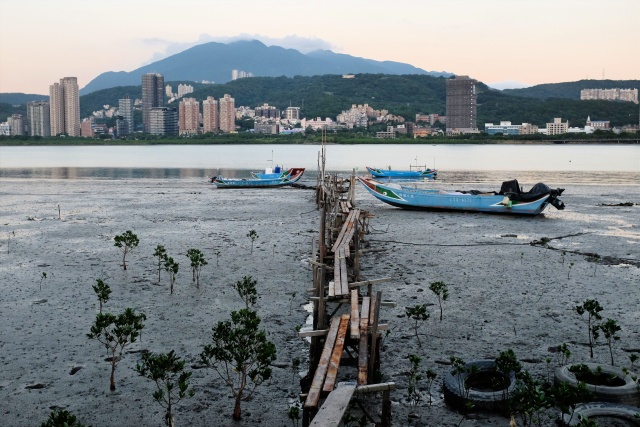
Bali: Evening on Tamsui River
I made my bed in the hayloft, this is what the building looked like. I was not afraid of the rain, but rather wanted to protect the tent against the all-pervasive moisture. What a nuisance. A watchman drove through the park every hour or so. He obviously was not aware of me, but even if he had been, the campsite was freely accessible. In the morning, I consumed my iron ration, boiling spaghetti with a can of chicken. The reserved hotel was only 20 km away, check-in at 15:00. I had not had so much free time for quite a while. I went down to the river to edit photos as long as the battery remained charged. I found a shopping mall in the GPS and spent a useless hour, then ate in the adjacent Carrefour, bought some supplies and at 14:30 arrived at my accommodation. It was easy to locate, as the hotel had GPS coordinates on its pages and so the different transcription could not confuse the map, whose Chinese characters made navigation difficult.





